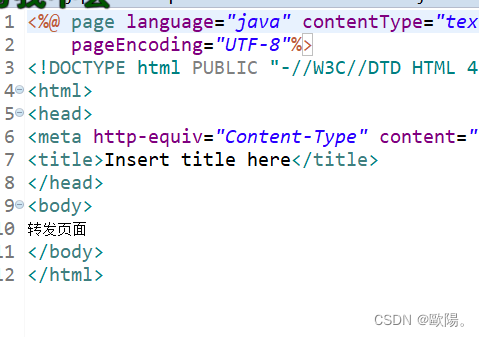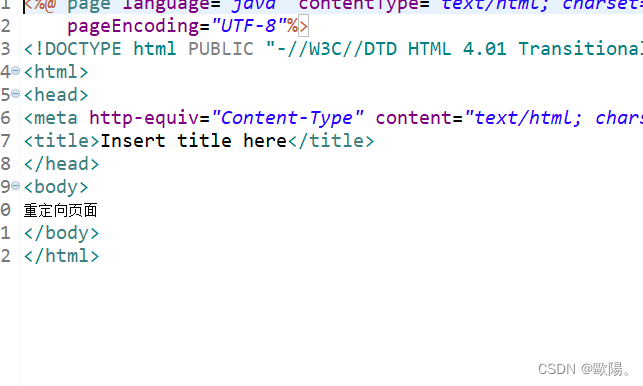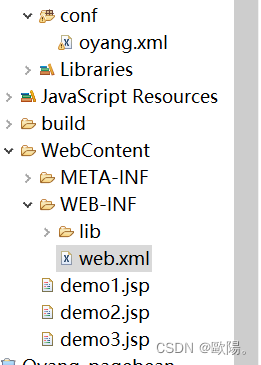目录
前言
上次我们认识了自定义MVC原理(http://t.csdn.cn/S5TWs),今天了解的内容是自定义mvc框架实现(基于上篇文章进行优化)
一、让中央控制器动态加载存储子控制器
通过建模我们可以知道,最终configModel对象会包含config.xml中所有子控制器信息,同时为了解决中央控制器能够动态加载保存子控制器的信息,那么我们只需要引入configModel对象即可
config.xml:
<?xml version="1.0" encoding="UTF-8"?>
<config>
<action path="/book" type="com.oyang.servlet.BookAction">
<forward name="failed" path="/demo2.jsp" redirect="false" />
<forward name="success" path="/demo3.jsp" redirect="true" />
</action>
<action path="/order" type="com.oyang.servlet.OrderAction">
<forward name="failed" path="/demo2.jsp" redirect="false" />
<forward name="success" path="/demo3.jsp" redirect="true" />
</action>
</config>优化DispatcherServlet:
package com.oyang.framework;
import java.io.IOException;
import java.util.HashMap;
import java.util.Map;
import javax.servlet.ServletException;
import javax.servlet.annotation.WebServlet;
import javax.servlet.http.HttpServlet;
import javax.servlet.http.HttpServletRequest;
import javax.servlet.http.HttpServletResponse;
import org.apache.commons.beanutils.BeanUtils;
import org.apache.commons.beanutils.PropertyUtils;
import com.oyang.servlet.BookAction;
/**
* 中央控制器:
* 主要职能,接收浏览器请求,找到对应的处理人
* @author yang
*
*/
//@WebServlet("*.action")
public class DispatcherServlet extends HttpServlet{
//private Map<String, Action> actions=new HashMap<String,Action>();
/**
* 通过建模我们可以知道,最终configModel对象会包含config.xml中的所有子控制器信息,
* 同时为了解决中央控制器能够动态加载保存子控制器的信息,那么我们只需要引入configModel对象即可
*/
private ConfigModel configModel;
//程序启动时 ,只会加载一次
@Override
public void init() throws ServletException {
//actions.put("/book",new BookAction());
//actions.put("/order",new BookAction());
try {
//配置地址
//getInitParameter的作用是拿到web.xml中的Servlet信息配置的参数
String configLocation = this.getInitParameter("configLocation");
if(configLocation==null || "".equals(configLocation))
configModel=ConfigModelFactory.bulid();
else
configModel=ConfigModelFactory.bulid(configLocation);
} catch (Exception e) {
e.printStackTrace();
}
}
@Override
protected void doGet(HttpServletRequest req, HttpServletResponse resp) throws ServletException, IOException {
doPost(req, resp);
}
//只要是以.action结尾的每次请求都会被doPost截取
@Override
protected void doPost(HttpServletRequest req, HttpServletResponse resp) throws ServletException, IOException {
http://localhost:8080/mvc/book.action?methodName=list
String uri = req.getRequestURI();
// 要拿到/book,就是最后一个/到最后一个.为止
uri= uri.substring(uri.lastIndexOf("/"),uri.lastIndexOf("."));
/**
* 思路:
* 以前我们从map集合中获取,那样的话就行不通了。那么该怎么办呢?此时我们就需要修改xml配置文件了。
* 通过配置文件拿到全路径名,再通过反射实例化
*/
//Action action = actions.get(uri);
//取到.action之后 Action action = actions.get(uri);里面定义了对应的方法
//相比于上一种从map集合获取子控制器,当前需要获取config.xml中的全路径名,然后反射实例化
ActionModel actionModel = configModel.pop(uri);
if(actionModel==null) {
throw new RuntimeException("action config eroer 配置错误");
}
String type = actionModel.getType();//拿到type值
//拿到type值之后就能通过路径名反射实例化 ------type是Action子控制器的全路径名
try {
Action action = (Action) Class.forName(type).newInstance();
//此时的action 是bookAction
if(action instanceof ModelDriven) {
ModelDriven md=(ModelDriven) action;
//action指的是bookAction,而bookAction又实现了ModelDriven接口,然后把bookAction转换成ModelDriven接口
Object model = md.getModel();//model指的是bookAction中的book实例
//给model中的属性赋值,要接收前端jsp传递过来的参数
//PropertyUtils.getProperty(bean, name);//从某一个对象里面取某一个值
//将前端所有参数值封装进实体类
BeanUtils.populate(model, req.getParameterMap());
System.out.println(model);
}
//正式调用方法之前,book中的属性要被赋值
// action.execute(req, resp);
String retult = action.execute(req, resp);
ForwardModel forwardModel = actionModel.pop(retult);
if(forwardModel==null) {
throw new RuntimeException("forward config error 配置错误");
}
// /bookList.jsp/index.jsp
String path = forwardModel.getPath();
//拿到是否需要转发的配置
boolean redirect = forwardModel.getRedirect();
if(redirect)
resp.sendRedirect(req.getServletContext().getContextPath()+path);
else
req.getRequestDispatcher(path).forward(req, resp);
} catch (Exception e) {
// TODO Auto-generated catch block
e.printStackTrace();
} //Action的实例
}
//由原来的actions.get(uri)变成了从模型对象里取
}
ConfigModel:
package com.oyang.framework;
import java.util.HashMap;
import java.util.Map;
/**
* 根标签对应的对象
* @author yang
*
* @date 2022年6月15日上午9:04:05
*/
public class ConfigModel {
private Map<String, ActionModel> aMap=new HashMap<String, ActionModel>();
public void push(ActionModel actionModel) {
aMap.put(actionModel.getPath(), actionModel);
}
public ActionModel pop(String path) {
return aMap.get(path);
}
}
ConfigModelFactory :
package com.oyang.framework;
import java.io.InputStream;
import java.util.List;
import org.dom4j.Document;
import org.dom4j.DocumentException;
import org.dom4j.Element;
import org.dom4j.io.SAXReader;
/**
* 23种设计模式之工厂模式
* sessionFactory
* ConfigModelFactory 就是用来生产configmodel对象的
* 生产出来的Configmodel对象就包含了config.xml中的配置内容
* @author yang
*
*此地生产configmodel有配置信息?
*1.解析config.xml中的配置信息
*2.将对应的配置信息分别加载进不同的模型对象中
* @date 2022年6月15日上午9:55:56
*/
public class ConfigModelFactory {
public static ConfigModel bulid(String path) throws Exception {
InputStream in = ConfigModelFactory.class.getResourceAsStream(path);
SAXReader sr=new SAXReader();
Document doc = sr.read(in);
List<Element> actionEles = doc.selectNodes("/config/action");
ConfigModel con=new ConfigModel();
for (Element actionM : actionEles) {
ActionModel actionModel = new ActionModel();
actionModel.setPath(actionM.attributeValue("path"));
actionModel.setType(actionM.attributeValue("type"));
//将forwardmodel赋值并且添加到actionmodel中
List<Element> forwardEles = actionM.selectNodes("forward");
for (Element element : forwardEles) {
ForwardModel forwardModel = new ForwardModel();
forwardModel.setName(element.attributeValue("name"));
forwardModel.setPath(element.attributeValue("path"));
// redirect:只能是false|true,允许空,默认值为false
forwardModel.setRedirect("true".equals(element.attributeValue("redirect")));
actionModel.push(forwardModel);
}
con.push(actionModel);
}
return con;
}
public static ConfigModel bulid() throws Exception {
String defaultPath="/config.xml";
return bulid(defaultPath);
}
}
ForwardModel :
package com.oyang.framework;
/**
* 对应forward标签
* @author yang
*
* @date 2022年6月15日上午9:05:38
*/
public class ForwardModel {
private String name;
private String path;
private boolean redirect;
public String getName() {
return name;
}
public void setName(String name) {
this.name = name;
}
public String getPath() {
return path;
}
public void setPath(String path) {
this.path = path;
}
public boolean getRedirect() {
return redirect;
}
public void setRedirect(boolean b) {
this.redirect = b;
}
}
效果:

二、 参数传递封装优化

同常的Servlet:
private void add(HttpServletRequest request, HttpServletResponse response) {
String bid = request.getParameter("bid");
String bname = request.getParameter("bname");
String price = request.getParameter("price");
Book b=new Book(Integer.valueOf(bid), bname, Float.valueOf(price));
//BookDao.add(b);
System.out.println(book);
//上述问题:如果一张表有20乃至50行数据,那岂不是要写那么多行去接收?如果有10张20条数据以上的表,那一个增加方法就得写很多行,甚至还有可能写错。大大的限制了我们的开发速度和效率
//为了避免上述问题,如果上述代码可以不写就好了,那就不会这么麻烦了。能否让它们默认就接收那么多值呢?那我们就去生产这样的一个框架
System.out.println("在同一个Servlet中调用add新增方法");
}上述问题:如果一张表有20乃至50行数据,那岂不是要写那么多行去接收?如果有10张20条数据以上的表,那一个增加方法就得写很多行,甚至还有可能写错。大大的限制了我们的开发速度和效率
解决方案:
为了避免上述问题,如果上述代码可以不写就好了,那就不会这么麻烦了。能否让它们默认就接收那么多值呢?那我们就去生产这样的一个框架
建立一个模型驱动接口,该接口目的是为了接受前台JSP传递的参数,并且封装到实体类中
ModelDriven<T> :
package com.oyang.framework;
/**
* 模型驱动接口:接收前台JSP传递的参数,并且封装到实体类中
* @author yang
*
* @date 2022年6月28日上午9:02:29
*/
public interface ModelDriven<T> {
//拿到将要封装的类实例 ModelDriven.getModel()//当你要调用这个方法的时候等价于-->new Book();
//此时new 的book是没有值的,我们去封装一下值
T getModel();
}
此时new 的book是没有值的,我们去封装一下值
BooKAction实现模型驱动接口:
package com.oyang.servlet;
import javax.servlet.http.HttpServletRequest;
import javax.servlet.http.HttpServletResponse;
import com.oyang.entity.Book;
import com.oyang.framework.Action;
import com.oyang.framework.ActionSupport;
import com.oyang.framework.ModelDriven;
public class BookAction extends ActionSupport implements ModelDriven<Book>{
private Book book=new Book();
private void list(HttpServletRequest request, HttpServletResponse response) {
System.out.println("在同一个Servlet中调用list查询方法");
}
private void load(HttpServletRequest request, HttpServletResponse response) {
System.out.println("在同一个Servlet中调用load回显方法");
}
private void edit(HttpServletRequest request, HttpServletResponse response) {
System.out.println("在同一个Servlet中调用edit修改方法");
}
private void del(HttpServletRequest request, HttpServletResponse response) {
System.out.println("在同一个Servlet中调用del删除方法");
}
private void add(HttpServletRequest request, HttpServletResponse response) {
System.out.println("在同一个Servlet中调用add新增方法");
}
@Override
public Book getModel() {
return book;
}
}
将DispatcherServlet进行近一步的优化:
package com.oyang.framework;
import java.io.IOException;
import java.util.HashMap;
import java.util.Map;
import javax.servlet.ServletException;
import javax.servlet.annotation.WebServlet;
import javax.servlet.http.HttpServlet;
import javax.servlet.http.HttpServletRequest;
import javax.servlet.http.HttpServletResponse;
import org.apache.commons.beanutils.BeanUtils;
import org.apache.commons.beanutils.PropertyUtils;
import com.oyang.servlet.BookAction;
/**
* 中央控制器:
* 主要职能,接收浏览器请求,找到对应的处理人
* @author yang
*
*/
//@WebServlet("*.action")
public class DispatcherServlet extends HttpServlet{
//private Map<String, Action> actions=new HashMap<String,Action>();
/**
* 通过建模我们可以知道,最终configModel对象会包含config.xml中的所有子控制器信息,
* 同时为了解决中央控制器能够动态加载保存子控制器的信息,那么我们只需要引入configModel对象即可
*/
private ConfigModel configModel;
//程序启动时 ,只会加载一次
@Override
public void init() throws ServletException {
//actions.put("/book",new BookAction());
//actions.put("/order",new BookAction());
try {
//配置地址
//getInitParameter的作用是拿到web.xml中的Servlet信息配置的参数
String configLocation = this.getInitParameter("configLocation");
if(configLocation==null || "".equals(configLocation))
configModel=ConfigModelFactory.bulid();
else
configModel=ConfigModelFactory.bulid(configLocation);
} catch (Exception e) {
e.printStackTrace();
}
}
@Override
protected void doGet(HttpServletRequest req, HttpServletResponse resp) throws ServletException, IOException {
doPost(req, resp);
}
//只要是以.action结尾的每次请求都会被doPost截取
@Override
protected void doPost(HttpServletRequest req, HttpServletResponse resp) throws ServletException, IOException {
http://localhost:8080/mvc/book.action?methodName=list
String uri = req.getRequestURI();
// 要拿到/book,就是最后一个/到最后一个.为止
uri= uri.substring(uri.lastIndexOf("/"),uri.lastIndexOf("."));
/**
* 思路:
* 以前我们从map集合中获取,那样的话就行不通了。那么该怎么办呢?此时我们就需要修改xml配置文件了。
* 通过配置文件拿到全路径名,再通过反射实例化
*/
//Action action = actions.get(uri);
//取到.action之后 Action action = actions.get(uri);里面定义了对应的方法
//相比于上一种从map集合获取子控制器,当前需要获取config.xml中的全路径名,然后反射实例化
ActionModel actionModel = configModel.pop(uri);
if(actionModel==null) {
throw new RuntimeException("action config eroer 配置错误");
}
String type = actionModel.getType();//拿到type值
//拿到type值之后就能通过路径名反射实例化 ------type是Action子控制器的全路径名
try {
Action action = (Action) Class.forName(type).newInstance();
//此时的action 是bookAction
if(action instanceof ModelDriven) {
ModelDriven md=(ModelDriven) action;
//action指的是bookAction,而bookAction又实现了ModelDriven接口,然后把bookAction转换成ModelDriven接口
Object model = md.getModel();//model指的是bookAction中的book实例
//给model中的属性赋值,要接收前端jsp传递过来的参数
//PropertyUtils.getProperty(bean, name);//从某一个对象里面取某一个值
//将前端所有参数值封装进实体类
BeanUtils.populate(model, req.getParameterMap());
// System.out.println(model);
}
//正式调用方法之前,book中的属性要被赋值
// action.execute(req, resp);
String retult = action.execute(req, resp);
ForwardModel forwardModel = actionModel.pop(retult);
if(forwardModel==null) {
throw new RuntimeException("forward config error 配置错误");
}
// /bookList.jsp/index.jsp
String path = forwardModel.getPath();
//拿到是否需要转发的配置
boolean redirect = forwardModel.getRedirect();
if(redirect)
resp.sendRedirect(req.getServletContext().getContextPath()+path);
else
req.getRequestDispatcher(path).forward(req, resp);
} catch (Exception e) {
// TODO Auto-generated catch block
e.printStackTrace();
} //Action的实例
}
//由原来的actions.get(uri)变成了从模型对象里取
}
效果:

我们可以看到原本Book没有值的当再一次点击的时候Book中又有值。 他大大减少了代码量,不管之后有多少属性,都可以接受属性值和封装
三、 对于方法执行结果转发重定向优化
对方法的执行结果进行优化,如果增加成功就用转发,失败就用重定向。
编辑.xml配置文件:
<?xml version="1.0" encoding="UTF-8"?>
<config>
<action path="/book" type="com.oyang.servlet.BookAction">
<forward name="failed" path="/demo2.jsp" redirect="false" />
<forward name="success" path="/demo3.jsp" redirect="true" />
</action>
<action path="/order" type="com.oyang.servlet.OrderAction">
<forward name="failed" path="/demo2.jsp" redirect="false" />
<forward name="success" path="/demo3.jsp" redirect="true" />
</action>
</config>对子控制器进行优化 Action :
package com.oyang.framework;
import javax.servlet.http.HttpServletRequest;
import javax.servlet.http.HttpServletResponse;
/**
* 子控制器
* 对应请求的处理人
* @author yang
*
*/
public interface Action {
String execute(HttpServletRequest request, HttpServletResponse response);
}
ActionSupport类:
package com.oyang.framework;
import java.lang.reflect.Method;
import javax.servlet.http.HttpServletRequest;
import javax.servlet.http.HttpServletResponse;
public class ActionSupport implements Action {
@Override
public String execute(HttpServletRequest request, HttpServletResponse response) {
String methodName = request.getParameter("methodName");
// methodName可能是add/del/edit/list/load/...
// 前台传递什么方法,就调用当前类的对应方法
try {
Method m = this.getClass()// 当前类.class
.getDeclaredMethod(methodName, HttpServletRequest.class, HttpServletResponse.class);
// 打开权限
m.setAccessible(true);
// 调用当前类实例的methodName 方法
return (String) m.invoke(this, request, response);
} catch (Exception e) {
// TODO Auto-generated catch block
e.printStackTrace();
}
return null;
}
}
DispatcherServlet:

上述代码有,在此标记出来
BookAction:(更改返回值)
package com.oyang.servlet;
import javax.servlet.http.HttpServletRequest;
import javax.servlet.http.HttpServletResponse;
import com.oyang.entity.Book;
import com.oyang.framework.Action;
import com.oyang.framework.ActionSupport;
import com.oyang.framework.ModelDriven;
public class BookAction extends ActionSupport implements ModelDriven<Book>{
private Book book=new Book();
private String list(HttpServletRequest request, HttpServletResponse response) {
System.out.println("在同一个Servlet中调用list查询方法");
return "success";
}
private void load(HttpServletRequest request, HttpServletResponse response) {
System.out.println("在同一个Servlet中调用load回显方法");
}
private void edit(HttpServletRequest request, HttpServletResponse response) {
System.out.println("在同一个Servlet中调用edit修改方法");
}
private void del(HttpServletRequest request, HttpServletResponse response) {
System.out.println("在同一个Servlet中调用del删除方法");
}
private String add(HttpServletRequest request, HttpServletResponse response) {
// String bid = request.getParameter("bid");
// String bname = request.getParameter("bname");
// String price = request.getParameter("price");
// Book b=new Book(Integer.valueOf(bid), bname, Float.valueOf(price));
//BookDao.add(b);
// System.out.println(book);
//上述问题:如果一张表有20乃至50行数据,那岂不是要写那么多行去接收?如果有10张20条数据以上的表,那一个增加方法就得写很多行,甚至还有可能写错。大大的限制了我们的开发速度和效率
//为了避免上述问题,如果上述代码可以不写就好了,那就不会这么麻烦了。能否让它们默认就接收那么多值呢?那我们就去生产这样的一个框架
System.out.println("在同一个Servlet中调用add新增方法");
return "failed";
}
@Override
public Book getModel() {
return book;
}
}
新建两个jsp界面,用于演示跳转转发&重定向


我们点击新增后的运行结果:

四、框架配置文本优化
以后我们使用的框架有很多,很有可能会重名,但是换了名字程序就跑不了了
对此问题我们只需要更改web.xml文件的配置就行了
<?xml version="1.0" encoding="UTF-8"?>
<web-app xmlns:xsi="http://www.w3.org/2001/XMLSchema-instance" xmlns="http://xmlns.jcp.org/xml/ns/javaee" xsi:schemaLocation="http://xmlns.jcp.org/xml/ns/javaee http://xmlns.jcp.org/xml/ns/javaee/web-app_3_1.xsd" id="WebApp_ID" version="3.1">
<display-name>Oyang_mvc</display-name>
<servlet>
<servlet-name>mvc</servlet-name>
<servlet-class>com.oyang.framework.DispatcherServlet</servlet-class>
<init-param><!-- 可以把值传到 configLocation中-->
<param-name>configLocation</param-name>
<param-value>/oyang.xml</param-value>
</init-param>
</servlet>
<servlet-mapping>
<servlet-name>mvc</servlet-name>
<url-pattern>*.action</url-pattern>
</servlet-mapping>
</web-app>
试试运行结果:
点击增加

跳转到转发界面

看一下控制台打印的值

敬请期待下篇J2EE基础-自定义MVC(下),下篇将会优化的更多
OK,今日的学习就到此结束啦,如果对个位看官有帮助的话可以留下免费的赞哦(收藏或关注也行),如果文章中有什么问题或不足以及需要改正的地方可以私信博主,博主会做出改正的。个位看官,小陽在此跟大家说拜拜啦























 114
114











 被折叠的 条评论
为什么被折叠?
被折叠的 条评论
为什么被折叠?










